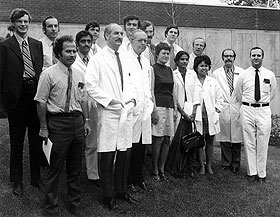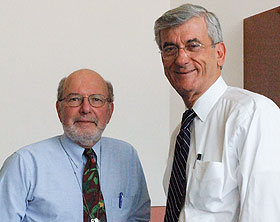Feature Story
As published in the UConn Advance, April 27, 2009.
Physician Recalls Early Days of Pediatric Residency Program
By Maureen McGuire

Participants in the pediatric residency program in 1971. Dr. Jose Muniz is in the back row, fifth from left. Dr. Robert Greenstein is second from the right, back row.
Photo courtesy of Dr. Robert Greenstein
Since Dr. Jose Muniz and a handful of others completed the first pediatric residency program at the UConn School of Medicine in 1973, nearly 600 pediatricians have followed in his footsteps.
More than 100 are now general pediatricians in Connecticut, and many others, like Muniz, are subspecialists throughout the state and elsewhere.
Muniz has a thriving practice specializing in allergies and immunology in Frederick, Md. He recently visited the Hartford area with Dr. Robert Greenstein, who was director of the pediatric residency program during Muniz’s training.
Together, they visited the Health Center’s Farmington campus and the Connecticut Children’s Medical Center, which has been the centerpiece of the pediatric residency program since it opened 13 years ago. Residents also now train at St. Francis Hospital and Medical Center and the Burgdorf/Bank of America Health Center.
When Muniz trained, however, neither the children’s hospital nor the Health Center existed. Instead, he rotated through the former McCook Hospital in Hartford, Hartford Hospital and the former New Britain General Hospital.
Muniz, who attended medical school in Peru at a sister school to Johns Hopkins University, said the UConn School of Medicine was his first choice for his residency because of the reputation of the faculty, particularly Dr. Milton Markowitz, the first chairman of the Department of Pediatrics.
“I knew it was a new program so a small group of us would have access to an outstanding faculty,” Muniz said. At that time, the faculty for the pediatric residency program included Drs. Markowitz, Greenstein, Robert Kramer, Pat Hurlbrink, and Martha Lepow.
Today, more than 120 full- and part-time faculty members support the residency program.
“There is a real life rhythm to the program,” says Dr. Edwin Zalneraitis, who currently serves as the pediatric residency director.

Dr. Robert Greenstein, left, and Dr. Jose Muniz. Greenstein was director of the pediatric residency training program during Muniz’s training.
Photo by Chris DeFrancesco
He notes that the residency program currently includes 17 physicians per year, and the number will increase to 20 next year as they introduce a new advocacy training track. In contrast to the early years, when the program was predominantly male, the vast majority of pediatric residents today are women.
“This reflects a national trend,” Zalneraitis says. “It is considered a more family-friendly field.”
But some things haven’t changed.
The program still offers a rigorous training for pediatricians to respond to the needs of patients and families – lessons that remain with Muniz today.
He says he vividly remembers an occasion during his residency when he was at the end of a grueling three-day stretch in the hospital.
Toward the end of the third day, he admitted a child with meningitis. When he finally came home later that day, he was no sooner in the door than the phone started ringing.
“It was Dr. Greenstein calling to tell me I had not completed the medical history for the last patient I had admitted,” Muniz recalls.
“I told him I couldn’t do it at the time because the child’s mother wasn’t available. Dr. Greenstein told me she was there now and he expected to see me soon. So, of course, I went back to work.
“Dr. Greenstein did not let us do anything that was incomplete,” he adds.
“He taught us a lot about the work ethic.”
On April 29, Connecticut will celebrate “Dr. Robert Greenstein Day” with a reception at the state capitol to honor his career at UConn.
This summer, he will step down as director of the Division of Human Genetics, although he will continue to see patients.


